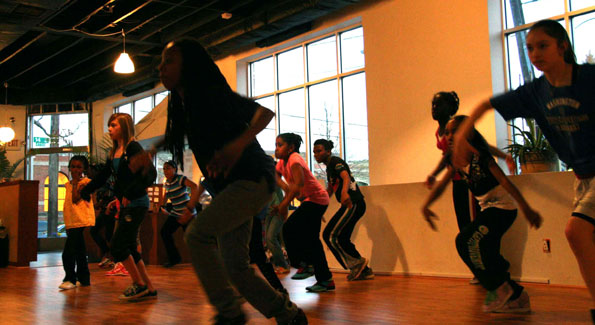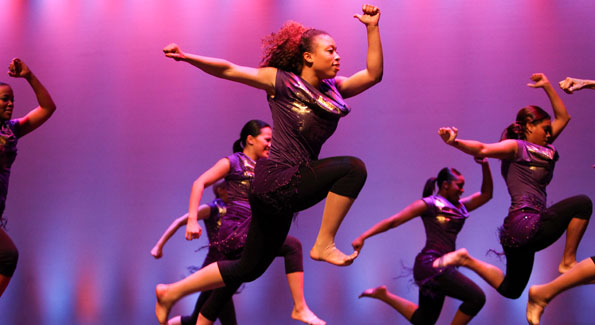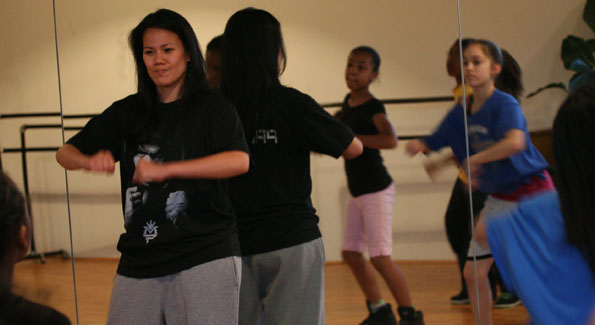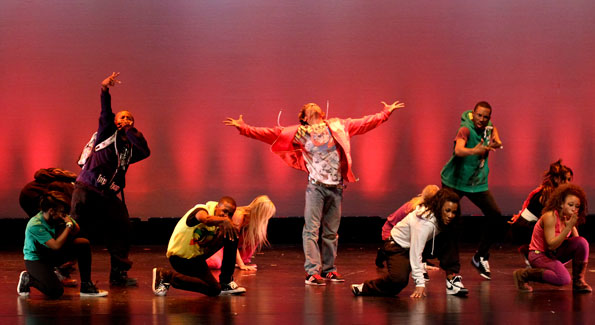Capitol Movement dances in step with the community.
By Dawn Lim
Hip-hop floods a dusk-lit studio where lithe bodies are hard at work. Jamie Esmedia is dispensing tough love, singling out anyone out of rhythm, making her 16 dancers – aged seven to 12 – do the drill over and over again. Outside, veiled women pass serenely on the way to the nearby Ethiopian Orthodox church on a Friday evening in Petworth. But the pace of this rehearsal is nothing but leisurely. “Because I’m not happy, you just have to do it again,” Shontal Snider, the teaching assistant, says over Black Eyed Peas’ “Imma Be.”
“Stop following other people,” Esmedia raps out. “I don’t want you to look at other people, I want you to look at yourself.” Esmedia is the assistant director of the jazz and hip hop-influenced dance company Capitol Movement and the director of its Capitol Kidz program, which trains seven- to 13-year-olds to dance on the Washington Wizards‘ court at basketball games. “I’m really hard on the kids,” she told me afterwards, “that’s how they really grow as dancers.”
Esmedia and Snider may seem like taskmasters, but Capitol Movement dances closely in step with the rest of the community. The company’s dancers reach out to public schools that lack arts programs, teaching kids – most of whom need free lunch programs – how to dance. This year, Capitol Movement will be reaching out to at least 10 public schools in the D.C., Maryland and Virginia.
Capitol Movement also provides free summer camps for kids each year in recreation centers located around the D.C. area. It gives the kids in its outreach programs – many of whom have never been to a dance performance – the chance to see the professional company in performance. The company taps into its community programs to find young people to audition for its pre-professional program or perform at NBA games. It has given out $15,000 in scholarships.
As mentors and teachers, the company’s dancers help underachieving kids in disadvantaged communities get passionate about movement. “Being in a dance class has a lot to do with discipline,” said the Amber Yancey, a co-founder of the company. “That’s a huge life skill.”
At the same time, because “our dancers have to work with kids who have never danced before, who are intimidated by other children, and in spaces that aren’t always ideal,” it forces the dancers to be more creative, said Yancey. “It keeps me on my toes as a dancer – especially if these kids are teaching me what the newest trends are,” Esmedia laughed.
From the get-go, Yancey, and co-founder Stephanie Jojokian, wanted their dance company to be a community-centered one when they set it up in 2005. They commissioned choreographers – from New York, Los Angeles and from within D.C. – to create original works for local dancers, and showcased these pieces at the annual Capitol Movement Project at the historic Lincoln Theatre. The result was an eclectic mix of jazz, hip-hop, ethnic- and gospel-influenced work – many with a strong group dynamic and an insistent social message.
For a nonprofit pulling all the strings it can to give dancers the opportunities they need, the going can get pretty tough. “It’s tiring,” Esmedia admitted. “But I can always count of the kids to give me the energy to do more.”




